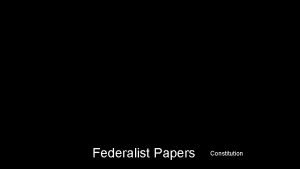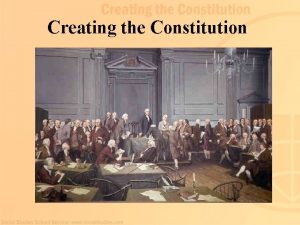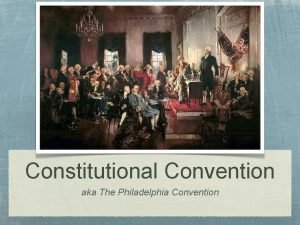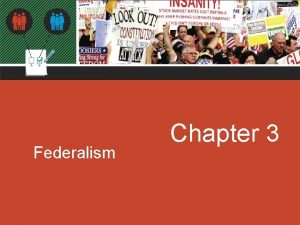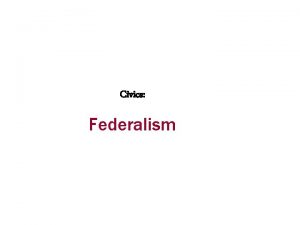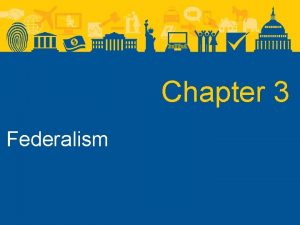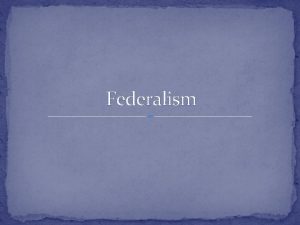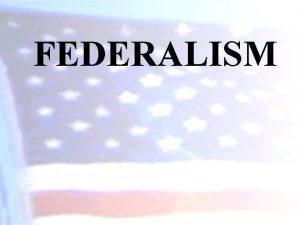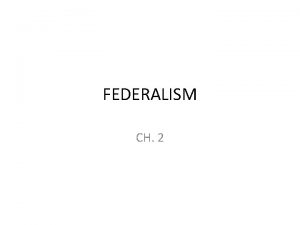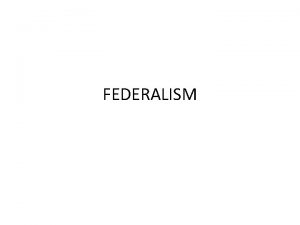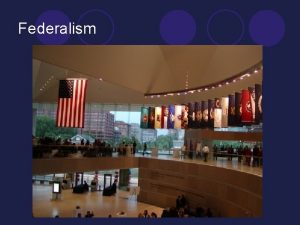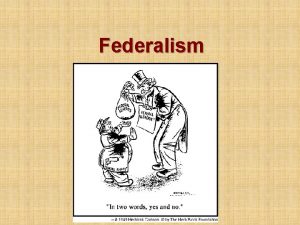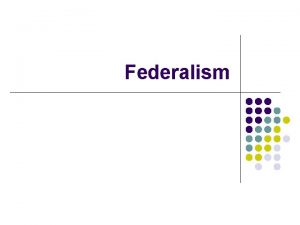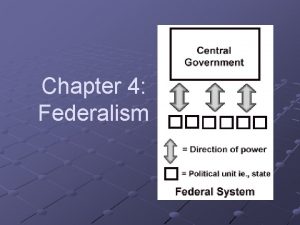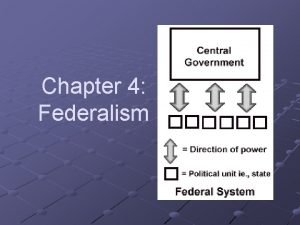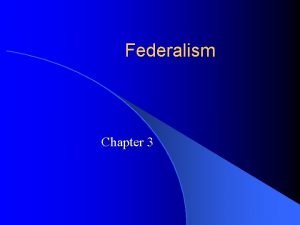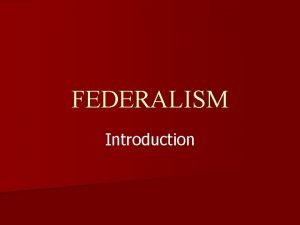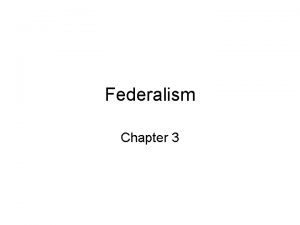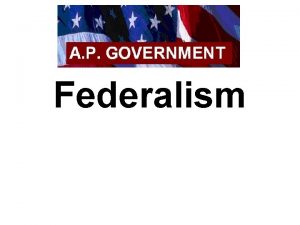Federalism Federalism in the Constitution Federalism A system






















- Slides: 22

Federalism

Federalism in the Constitution • Federalism: A system in which the national government shares power with lower levels of government. • The United States Constitution divides power between the federal and state governments.

Federalism in the Constitution • Why federalism? – The original states already existed at the time of the Revolution. – The states created the federal government, not the other way around. – The former colonists distrusted strong, central governments.

Federalism in the Constitution • The Constitution grants two types of powers to federal government: expressed and implied. – Expressed powers (17 of them) are found in Article I, Section 8 of the Constitution. – Implied powers are found at the end of Section 8, which grants Congress the right “To make all Laws which shall be necessary and proper for carrying into Execution” the expressed powers

Federalism in the Constitution • Article VI also says that the laws of Congress shall be “the supreme Law of the Land. ” • Known as the “supremacy clause, ” this means than when a federal and state law collide, the federal one will dominate

Federalism in the Constitution • States have significant powers, too. – Tenth Amendment – Police powers – Concurrent powers

Federalism in the Constitution

Federalism in the Constitution Full Faith and Credit Clause: Article IV, Section 1 – Requires states give “full faith and credit” to each other’s “public acts, records, and judicial proceedings. ”

Federalism in the Constitution

Federalism in the Constitution • Article I, Section 10, “No State shall, without the Consent of Congress … enter into any Agreement or Compact with another State” – Compacts are agreements between states to deal with issues that cross state lines, such as environmental concerns and transportation systems.

89, 527 Governments in the United States (and counting. . . )

Dual Federalism, 1789– 1937 • Dual Federalism: a constitutional interpretation that gave the federal government exclusive control over some issues, and states exclusive control over others. • The federal government was small and dealt primarily with foreign affairs and commerce. – Internal improvements, like roads and canals – Tariffs (taxes on imports), patents, currency

Dual Federalism, 1789– 1937 • States performed the majority of governing over citizens’ day-to-day lives. – Property law – Civil law (marriage, divorce, adoption) – Criminal law • Dual federalism allowed states to experiment with policies. – Very different sets of rights from state to state

Dual Federalism, 1789– 1937 • It took more than 150 years for the federal government to extend its power over the domestic sphere. • A series of Supreme Court decisions produced these fundamental shifts. – Mc. Culloch v. Maryland – Gibbons v. Ogden

Dual Federalism, 1789– 1937 • Since the New Deal, the federal government has been able to use the Commerce Clause to regulate large swaths of domestic activities. • Congress can also influence the states to enact laws by promising them federal funds to do so, or to threat to withdraw funds if they do not.

The New Deal • Grants-in-aid (categorical grants) – Funds provided by federal government to state or local government for a specific purpose – New Deal expanded to include social programs – Includes competitive project grants • State and local governments compete for funds based on merit of their proposals

Cooperative Federalism • Cooperative federalism: model in which the various levels of government work together to solve policy problems, often with the federal government providing some portion of the funding, which is spent by the states or localities

Cooperative Federalism • Expansion of national power diminishes the old paradigm of dual federalism. • Cooperation between state and national governments replaces dual federalism. • Morton Grodzins cake analogy: – Dual federalism as layer cake – Cooperative federalism as marble cake

Dual versus Cooperative Federalism

Cooperative Federalism • Regulated federalism – With increased funding, the federal government demanded higher standards and stricter uses for funds. • Preemption – The principal that allows national government to override state/local actions in certain policy areas – Occurs when state/local actions do not agree with national requirements

Cooperative Federalism • Congress dramatically increased unfunded mandates: rules forcing states to spend their own money to comply with federal law. • Backlash to federal preemption and unfunded mandates led to calls for devolution: transferring responsibility from federal government to state/local governments – Popular since the 1970 s – Idea led to New Federalism

New Federalism • New Federalism: Nixon and Reagan efforts to devolve many policies back to the states. – Block grants – General revenue sharing – Smaller federal spending and interference • Reagan cut federal aid to states by 12 percent. – The idea was to remove federal government, as much as possible, from local matters governed by the states.
 Pubilus
Pubilus Federalism in the constitution
Federalism in the constitution Federalism in the constitution
Federalism in the constitution Texas constitution vs u.s. constitution venn diagram
Texas constitution vs u.s. constitution venn diagram Nc constitution vs us constitution
Nc constitution vs us constitution Constitution what is constitution
Constitution what is constitution The constitution lesson 1 principles of the constitution
The constitution lesson 1 principles of the constitution Hát kết hợp bộ gõ cơ thể
Hát kết hợp bộ gõ cơ thể Bổ thể
Bổ thể Tỉ lệ cơ thể trẻ em
Tỉ lệ cơ thể trẻ em Chó sói
Chó sói Glasgow thang điểm
Glasgow thang điểm Hát lên người ơi
Hát lên người ơi Các môn thể thao bắt đầu bằng tiếng nhảy
Các môn thể thao bắt đầu bằng tiếng nhảy Thế nào là hệ số cao nhất
Thế nào là hệ số cao nhất Các châu lục và đại dương trên thế giới
Các châu lục và đại dương trên thế giới Công thức tính thế năng
Công thức tính thế năng Trời xanh đây là của chúng ta thể thơ
Trời xanh đây là của chúng ta thể thơ Cách giải mật thư tọa độ
Cách giải mật thư tọa độ 101012 bằng
101012 bằng Phản ứng thế ankan
Phản ứng thế ankan Các châu lục và đại dương trên thế giới
Các châu lục và đại dương trên thế giới
